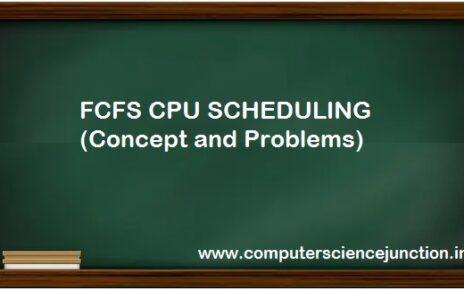1) The collection of processes on the disk that is waiting to be brought into memory for execution forms the ___________
1 Ready queue
2 Device queue
3 Input queue
4 Priority queue
Ans ) 3
2) Demand paged memory allocation
1 allows the virtual address space to be independent of the physical memory
2 allows the virtual address space to be a multiple of the physical memory size
3 allows deadlock tobe detected in paging schemes
4 is present only in Windows NT
Ans ) 1
3) Which is not an Operating System ?
1 Windows 95
2 MS-DOS
3 Windows 3.1
4 Windows 2000
Ans ) 3
4) The operating system manages ________.
1 Memory
2 Processor
3 Disk and I/O devices
4 All of the above
Ans ) 4
5) It is not the layer of the Operating system.
1 Kernel
2 Shell
3 Application program
4 Critcal Section
Ans ) 4
6) ___________ begins at the root and follows a path down to the specified file
1 Relative path name
2 Absolute path name
3 Standalone name
4 All of the above
Ans ) 2
7) Who is called a supervisor of computer acitvity ?
1 CPU
2 Operating system
3 Control unit
4 Application Program
Ans ) 2
8) Consider the two statements. (A) Protection is an internal problem. (B) Security is considered as an external environment within which the system works. Which of the statement is not true?
1 Only A
2 Only B
3 Both A and B
4 None of the above
Ans ) 4
9) The process related to process control, file management, device management, information about system and communication that is requested by any higher level language can be performed by __________.
1 Editors
2 Compilers
3 System Call
4 Caching
Ans ) 3
10) Mutual exclusion
1 if one process is in a critical region others are excluded
2 prevents deadlock
3 requires semaphores to implement
4 is found only in the Windows NT operating system
Ans ) 1
11) Which scheduler controls the degree of multiprogramming?
1 Short term scheduler
2 Long term scheduler
3 Middle term scheduler
4 None of the above
Ans ) 2
12) What is the name of the software which can be legally compiled and often used for free?
1 Shareware program
2 Public domain program
3 Firmware program
4 Mind Ware
Ans ) 2
13) The problem of fragmentation arises in ________.
1 Static storage allocation
2 Stack allocation storage
3 Stack allocation with dynamic binding
4 Heap allocation
Ans ) 4
14) In interactive environments such as time-sharing systems, the primary requirement is to provide reasonably good response time and in general, to share system resources equitably. In such situations, the scheduling algorithm that is most popularly applied is ________.
1 Shortest Remaining Time Next (SRTN) Scheduling
2 Priority Based Preemptive Scheduling
3 Round Robin Scheduling
4 None of the above
Ans ) 3
15) Thrashing occurs ________.
1 when excessive swapping takes place
2 when you thrash your computer
3 whenever deadlock occurs
4 when no swapping takes place
Ans ) 1
16) Boundary registers ________.
1 Are available in temporary program variable storage
2 Are only necessary with fixed partitions
3 Track the beginning and ending the program
4 Track page boundaries
Ans ) 3
17) The principle of locality of reference justifies the use of ________.
1 Virtual Memory
2 Interrupts
3 Main memory
4 Cache memory
Ans ) 4
18) The section of code which accesses shared variables is called as __________.
1 Critical section
2 Block
3 Procedure
4 Semaphore
Ans ) 1
19) Thrashing ________.
1 Reduces page I/O
2 Decreases the degree of multiprogramming
3 Implies excessive page I/O
4 Improve the system performance
Ans ) 3
20) In memory management , a technique called as paging, physical memory is broken into fixed-sized blocks called ___________.
1 Pages
2 Frames
3 Blocks
4 Segments
Ans ) 2
21) The state of a process after it encounters an I/O instruction is __________.
1 Ready
2 Blocked/Waiting
3 Idle
4 Running
Ans ) 2
22) In one of the deadlock prevention methods, impose a total ordering of all resource types, and require that each process requests resources in an increasing order of enumeration. This voilates the _______________ condition of deadlock
1 Mutual exclusion
2 Hold and Wait
3 Circular Wait
4 No Preemption
Ans ) 3
23) Which of the following file name extension suggests that the file is Backup copy of another file ?
1 TXT
2 COM
3 BAS
4 BAK
Ans ) 4
24) The degree of Multiprogramming is controlled by
1 CPU Scheduler
2 Context Switching
3 Long-term Scheduler
4 Medium term Scheduler
Ans ) 3
25) The higher versions of operating systems are so written that programs designed for earlier versions can still be run. What is it called ?
1 Up gradiability
2 Upward mobility
3 Universality
4 Upward Compatibility
Ans ) 4
26) A scheduling algorithm is fair
1 if no process faces starvation
2 if a process is starved, detect it and run it with high priority
3 if it uses semaphores
4 only if a queue is used for scheduling
Ans ) 1
27) A critical region
1 is a piece of code which only one process executes at a time
2 is a region prone to deadlock
3 is a piece of code which only a finite number of processes execute
4 is found only in Windows NT operation system
Ans ) 1
28) Semaphore can be used for solving __________.
1 Wait & signal
2 Deadlock
3 Synchronization
4 Priority
Ans ) 3
29) The operating system of a computer serves as a software interface between the user and the ________.
1 Hardware
2 Peripheral
3 Memory
4 Screen
Ans ) 1
30) What is the name of the software which deals with the running of the actual computer and not with the programming problems?
1 Operating system
2 System program
3 Object program
4 Source program
Ans ) 2
Operating System is an Important and core subject of Computer Science. All most in every competitive exam several questions are asked from this operating system in the Computer Awareness Section of the written exam. In this post I am presenting some basic objective questions from operating system.





